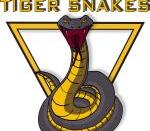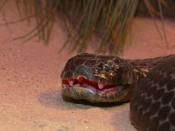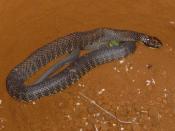Scientific: Name is Notechis scutatus.
CHARACTERISTICS: Tiger snakes are shy but will sometimes stand their ground before an intruder. When disturbed, tiger snakes may become extremely aggressive; they will flatten their necks and hiss to warn off predators, they usually strike low to the ground but very fast. Tiger snakes are active mainly at daytime or at dusk, but in hot weather they like to hunt at night.
HABITAT: Tiger snakes prefer swampy or marshy ground, where they cane hunt frogs around creeks, rivers or dams. They will come to farms and outer suburban houses, where they hunt mice and rats. They also climb trees or shrubs wile hunting.
FOOD: Tiger snakes favourite food is frogs. But sometimes they eat small birds, mice, rats, eels, fish, other snakes, lizards and tadpoles.
FOUND: Tiger snakes are found along the wetter and damper parts of the south eastern coast of Australia, including Victoria, eastern New South Wales, part of South Australia and Tasmania.
APPEARANCE: Tiger snakes are solidly built, with broad, flattened heads.
Their back usually has 40-50 bands of yellow or cream on a background of grey, green or brown. Their belly cane be cream, yellow, olive or grey. There are 15 to 19 rows of scales around the middle of the body. The belly has 140 to 190 scales.
SIZE: About 1.4-2.0m long.
BREEDING: Tiger snakes usually breeds in spring.
EGGS: Tiger snakes lay about 30 eggs a year.
YOUNG: born in late summer after mating in spring. Tiger snakes holding the eggs in their abdomen until they hatch, and giving birth to live young. The young remain with their mother for some time before leaving her.
RISK TO HUMANS: More than 3000 Australians are hospitalised each year from tiger snakebites. The Tiger snakes venom is highly toxic...


